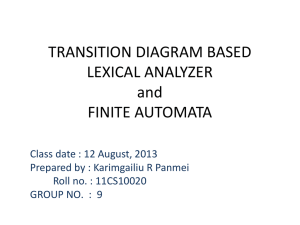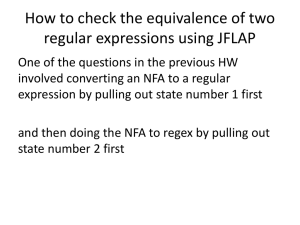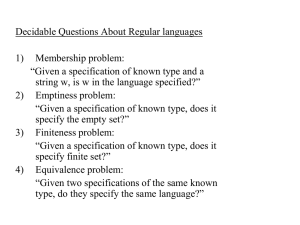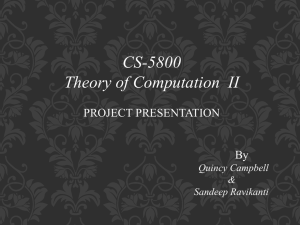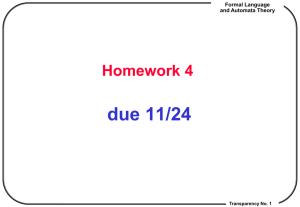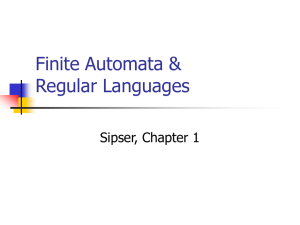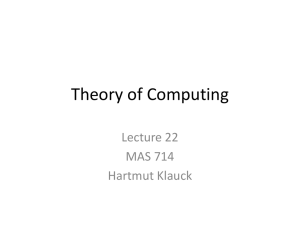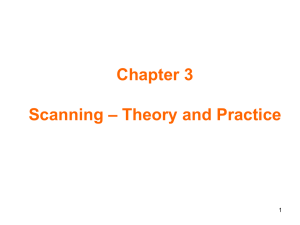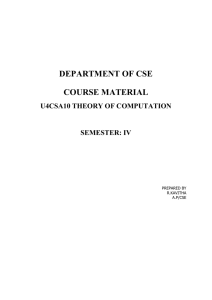Finite Automata
advertisement
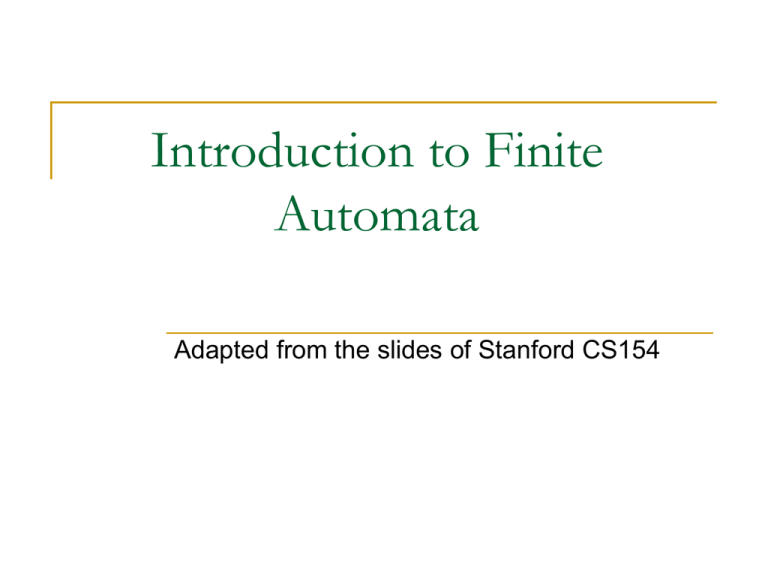
Introduction to Finite
Automata
Adapted from the slides of Stanford CS154
Informal Explanation
Finite automata
Original application
finite collections of states with transition rules
that take you from one state to another.
sequential switching circuits, where the “state”
was the settings of internal bits.
Today, several kinds of software can be
modeled by FA.
2
Representing FA
Simplest representation is often a graph.
Nodes = states.
Arcs indicate state transitions.
Labels on arcs tell what causes the transition.
3
Example: Recognizing Strings Ending
in “ing”
Not i or g
Not i
Not i or n
nothing
Start
i
i
Saw i
Saw in
n
g
Saw ing
i
4
Automata to Code
In C/C++, make a piece of code for each
state. This code:
1.
2.
3.
Reads the next input.
Decides on the next state.
Jumps to the beginning of the code for that
state.
5
Example: Automata to Code
2: /* i seen */
c = getNextInput();
if (c == ’n’) goto 3;
else if (c == ’i’) goto 2;
else goto 1;
3: /* ”in” seen */
. . .
6
Deterministic Finite Automata
A formalism for defining languages,
consisting of:
1.
2.
3.
4.
5.
A finite set of states (Q, typically).
An input alphabet (Σ, typically).
A transition function (δ, typically).
A start state (q0, in Q, typically).
A set of final states (F ⊆ Q, typically).
“Final” and “accepting” are synonyms.
7
The Transition Function
Takes two arguments:
a state and an input symbol.
δ(q, a) = the state that the DFA goes to when
it is in state q and input a is received.
8
Graph Representation of DFA’s
Nodes = states.
Arcs represent transition function.
Arc from state p to state q labeled by all those
input symbols that have transitions from p to q.
Arrow labeled “Start” to the start state.
Final states indicated by double circles.
9
Example: Graph of a DFA
Accepts all strings without two consecutive 1’s.
0
0,1
1
1
A
Start
B
C
0
Previous
string OK,
does not
end in 1.
Previous
String OK,
ends in a
single 1.
Consecutive
1’s have
been seen.
10
Alternative Representation: Transition
Table
Final states
starred
*
Arrow for
start state
*
A
B
C
0
1
A
A
C
B
C
C
Columns =
input symbols
Rows = states
11
Extended Transition Function
We describe the effect of a string of inputs on
a DFA
by extending δ to a state and a string.
Induction on length of string.
Basis: δ(q, ε) = q
Induction: δ(q,wa) = δ(δ(q,w),a)
w is a string; a is an input symbol.
12
Extended δ: Intuition
Convention:
… w, x, y, x are strings.
a, b, c,… are single symbols.
Extended δ is computed for state q and
inputs a1a2…an by following a path in the
transition graph, starting at q and selecting
the arcs with labels a1, a2,…,an in turn.
13
Example: Extended Delta
A
B
C
0
1
A
A
C
B
C
C
δ(B,011) = δ(δ(B,01),1) = δ(δ(δ(B,0),1),1) = δ(δ(A,1),1) = δ(B,1) = C
14
Language of a DFA
Automata of all kinds define languages.
If A is an automaton, L(A) is its language.
For a DFA A, L(A) is the set of strings
labeling paths from the start state to a final
state.
Formally: L(A) = the set of strings w such
that δ(q0, w) is in F.
15
Example: String in a Language
String 101 is in the language of the DFA below.
Start at A.
0
0,1
1
1
A
Start
B
C
0
16
Example: String in a Language
String 101 is in the language of the DFA below.
Follow arc labeled 1.
0
0,1
1
1
A
Start
B
C
0
17
Example: String in a Language
String 101 is in the language of the DFA below.
Then arc labeled 0 from current state B.
0
0,1
1
1
A
Start
B
C
0
18
Example: String in a Language
String 101 is in the language of the DFA below.
Finally arc labeled 1 from current state A. Result
is an accepting state, so 101 is in the language.
0
0,1
1
A
Start
1
B
C
0
19
Example – Concluded
The language of our example DFA is:
{w | w is in {0,1}* and w does not have
two consecutive 1’s}
Such that…
These conditions
about w are true.
Read a set former as
“The set of strings w…
20
Regular Languages
A language L is regular if it is the language
accepted by some DFA.
Note: the DFA must accept only the strings in L,
no others.
Some languages are not regular.
Intuitively, regular languages “cannot count” to
arbitrarily high integers.
21
Example: A Nonregular Language
L1 = {0n1n | n ≥ 1}
Note: ai is conventional for i a’s.
Thus, 04 = 0000, e.g.
Read: “The set of strings consisting of n 0’s
followed by n 1’s, such that n is at least 1.
Thus, L1 = {01, 0011, 000111,…}
22
Another Example
L2 = {w | w in {(, )}* and w is balanced }
Note: alphabet consists of the parenthesis
symbols ’(’ and ’)’.
Balanced parens are those that can appear in
an arithmetic expression.
E.g.: (), ()(), (()), (()()),…
23
But Many Languages are Regular
Regular Languages can be described in
many ways, e.g., regular expressions.
They appear in many contexts and have
many useful properties.
Example: the strings that represent floating
point numbers in your favorite language is a
regular language.
24
Nondeterminism
A nondeterministic finite automaton has the
ability to be in several states at once.
Transitions from a state on an input symbol
can be to any set of states.
25
Nondeterminism – (2)
Start in one start state.
Accept if any sequence of choices leads to a
final state.
Intuitively: the NFA always “guesses right.”
26
Formal NFA
A finite set of states, typically Q.
An input alphabet, typically Σ.
A transition function, typically δ.
A start state in Q, typically q0.
A set of final states F ⊆ Q.
27
Transition Function of an NFA
δ(q, a) is a set of states.
Extend to strings as follows:
Basis: δ(q, ε) = {q}
Induction: δ(q, wa) = the union over all states
p in δ(q, w) of δ(p, a)
28
Language of an NFA
A string w is accepted by an NFA if δ(q0, w)
contains at least one final state.
The language of the NFA is the set of strings
it accepts.
29
Equivalence of DFA’s, NFA’s
A DFA can be turned into an NFA that
accepts the same language.
If δD(q, a) = p, let the NFA have δN(q, a)
= {p}.
Then the NFA is always in a set containing
exactly one state – the state the DFA is in
after reading the same input.
30
Equivalence – (2)
Surprisingly, for any NFA there is a DFA
that accepts the same language.
Proof is the subset construction.
The number of states of the DFA can be
exponential in the number of states of the
NFA.
Thus, NFA’s accept exactly the regular
languages.
31
Subset Construction
Given an NFA with states Q, inputs Σ,
transition function δN, state state q0, and
final states F, construct equivalent DFA
with:
States 2Q (Set of subsets of Q).
Inputs Σ.
Start state {q0}.
Final states = all those with a member of F.
32
Subset Construction – (2)
The transition function δD is defined by:
δD({q1,…,qk}, a) is the union over all i = 1,…,k
of δN(qi, a).
33
Proof of Equivalence:
Subset Construction
Show by induction on |w| that
δN(q0, w) = δD({q0}, w)
Basis: w = ε: δN(q0, ε) = δD({q0}, ε) = {q0}.
34
Induction
Assume IH (Induction Hypothesis) holds for
strings shorter than w.
Let w = xa; IH holds for x.
Let δN(q0, x) = δD({q0}, x) = S.
Let T = the union over all states p in S of δN(p,
a).
Then δN(q0, w) = δD({q0}, w) = T.
For NFA: the extension of δN.
For DFA: definition of δD plus extension of δD.
That is, δD(S, a) = T; then extend δD to w = xa.
35
NFA’s With ε-Transitions
We can allow state-to-state transitions on ε
input.
These transitions are done spontaneously,
without looking at the input string.
A convenience at times, but still only regular
languages are accepted.
36
Example: ε-NFA
ε
1
1
1
B
C
ε
A
ε
D
0
0
E
0
F
37
Subset construction in the Textbook
Subset construction in the Textbook
(cont.)
